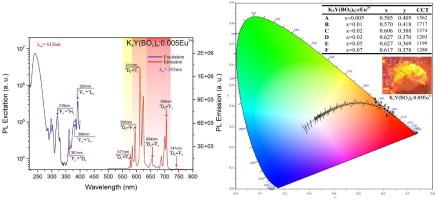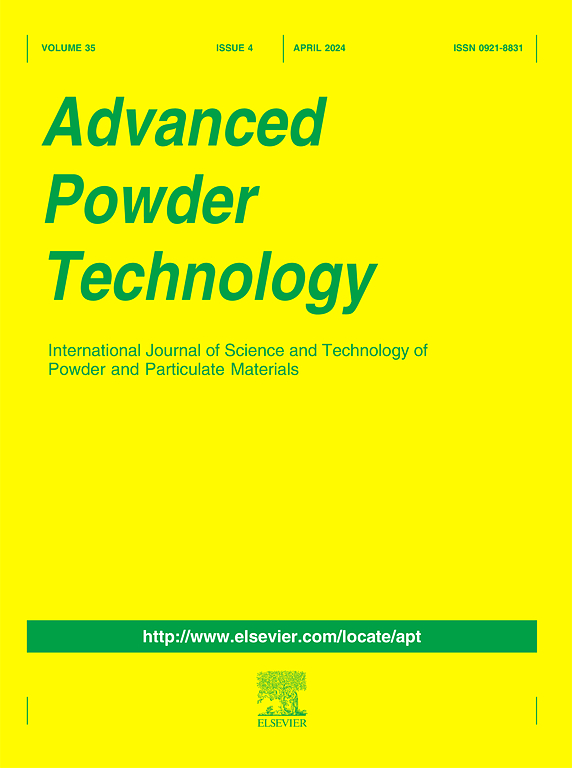掺杂 Li+ 和 Na+ 的 Eu3+ 掺杂 K3Y(BO2)6 的发光性能和热稳定性的增强
IF 4.2
2区 工程技术
Q2 ENGINEERING, CHEMICAL
引用次数: 0
摘要
通过微波辅助溶胶-凝胶法合成了掺杂 Eu3+ 和 Li+/Na+ 的 K3Y(BO2)6(KYBO)荧光粉,并考察了它们的结构和光致发光(PL)特性。X 射线衍射(XRD)和里特维尔德精炼证实了掺杂剂的有效掺入和晶体结构的保持。傅立叶变换红外光谱(FTIR)表明硼酸盐结构得以保持,证实了掺杂后荧光粉结构的完整性。加入 Li+ 和 Na+ 共掺杂剂后,发光效率和热稳定性显著提高,使这些荧光粉有望应用于固态照明(SSL)。聚光分析表明,在 612 纳米波长处有很强的红色发射峰,这归因于 Eu3+ 离子的 5Do → 7F2 转变。研究表明,电偶极子-四极子相互作用是能量迁移的主要机制,临界距离约为 22.68 Å。高温聚光测量表明,在共掺杂 Li+ 的样品中,热淬火的活化能为 0.1389 eV。此外,共掺杂 Na+ 的样品表现出异常的热稳定性,活化能更高,达到 0.2536 eV。这表明,Na+ 共掺杂大大增强了荧光粉的热稳定性,使其更适合在极端条件下工作的大功率发光应用。CIE 色度图凸显了优化 Eu3+ 掺杂水平以及 Li+ 和 Na+ 共掺的潜力,从而提高先进固态照明应用的发光性能和热稳定性。本文章由计算机程序翻译,如有差异,请以英文原文为准。

Enhancement of luminescence and thermal stability in Eu3+-doped K3Y(BO2)6 with Li+ and Na+ co-doping
Eu3+-doped and Li+/Na+ co-doped K3Y(BO2)6 (KYBO) phosphors were synthesized through a microwave-assisted sol–gel method, and their structural and photoluminescent (PL) characteristics were examined. X-ray diffraction (XRD) and Rietveld refinement confirm effective dopant incorporation and preservation of the crystalline structure. Fourier Transform Infrared (FTIR) spectroscopy indicates the maintenance of the borate structure, confirming the structural integrity of the phosphors upon doping. The addition of Li+ and Na+ co-dopants notably enhances luminescent efficiency and thermal stability, making these phosphors promising candidates for solid-state lighting (SSL) applications. PL analysis reveals strong red emission peaks at 612 nm, attributed to the 5Do → 7F2 transition of Eu3+ ions. The study indicates that electric dipole-quadrupole interactions are the primary mechanism for energy migration, with a critical distance of approximately 22.68 Å. This mechanism contributes to concentration quenching at higher doping levels. High temperature PL measurements indicated an activation energy of 0.1389 eV for thermal quenching in the Li+ co-doped sample. Additionally, the Na+ co-doped sample exhibited an abnormal thermal stability behavior, with an even higher activation energy of 0.2536 eV. This suggests that Na+ co-doping significantly enhances the thermal resilience of the phosphor, making it more suitable for high-power light-emitting applications that operate under extreme conditions. CIE chromaticity diagrams highlight the potential for optimizing Eu3+ doping levels, combined with Li+ and Na+ co-doping, to improve luminescent performance and thermal stability for advanced SSL applications.
求助全文
通过发布文献求助,成功后即可免费获取论文全文。
去求助
来源期刊

Advanced Powder Technology
工程技术-工程:化工
CiteScore
9.50
自引率
7.70%
发文量
424
审稿时长
55 days
期刊介绍:
The aim of Advanced Powder Technology is to meet the demand for an international journal that integrates all aspects of science and technology research on powder and particulate materials. The journal fulfills this purpose by publishing original research papers, rapid communications, reviews, and translated articles by prominent researchers worldwide.
The editorial work of Advanced Powder Technology, which was founded as the International Journal of the Society of Powder Technology, Japan, is now shared by distinguished board members, who operate in a unique framework designed to respond to the increasing global demand for articles on not only powder and particles, but also on various materials produced from them.
Advanced Powder Technology covers various areas, but a discussion of powder and particles is required in articles. Topics include: Production of powder and particulate materials in gases and liquids(nanoparticles, fine ceramics, pharmaceuticals, novel functional materials, etc.); Aerosol and colloidal processing; Powder and particle characterization; Dynamics and phenomena; Calculation and simulation (CFD, DEM, Monte Carlo method, population balance, etc.); Measurement and control of powder processes; Particle modification; Comminution; Powder handling and operations (storage, transport, granulation, separation, fluidization, etc.)
 求助内容:
求助内容: 应助结果提醒方式:
应助结果提醒方式:


